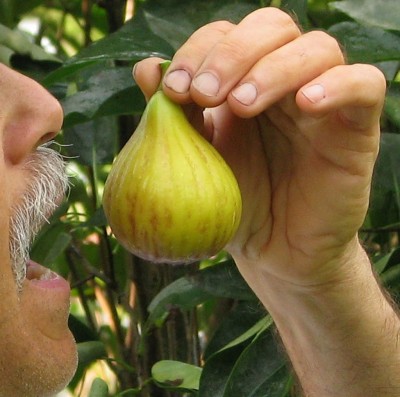Of Crocs and Glads
/11 Comments/in Flowers, Gardening/by Lee ReichNo-Dig Crocs
Plants grow and multiply, which sometimes causes trouble. Such trouble was highlighted this week as I was digging up my crocosmia bulbs.
 Backpedaling perhaps 20 years, you would have found me ordering crocosmia bulbs from a mail-order catalog. I’d seen the plants blooming in a friend’s garden in New Jersey and marveled at the graceful flower stems that arched up and out from clumps of sword-shaped leaves. Lined up near the ends of each flower stalk were pairs of tubular, hot scarlet blossoms.
Backpedaling perhaps 20 years, you would have found me ordering crocosmia bulbs from a mail-order catalog. I’d seen the plants blooming in a friend’s garden in New Jersey and marveled at the graceful flower stems that arched up and out from clumps of sword-shaped leaves. Lined up near the ends of each flower stalk were pairs of tubular, hot scarlet blossoms.
Crocosmia isn’t supposed to be cold-hardy outdoors where winter temperatures drop below minus 10 degrees F. (hardiness zone 5), so the first couple of autumns, as instructed, I dug up the bulbs for winter storage. Each spring following, the plants would get off to a slow start, finally blooming late in the season or not at all.
In disappointment or laziness, I stopped digging the bulbs up each fall. I was surprised to see them appear in spring anyway. Not only did they appear in spring; they had some real oomph, growing almost as luxuriantly as the ones in my friend’s garden. To make matters better, they started blooming earlier, in July, and in great profusion, and they have done so reliably year after year with no help at all from me.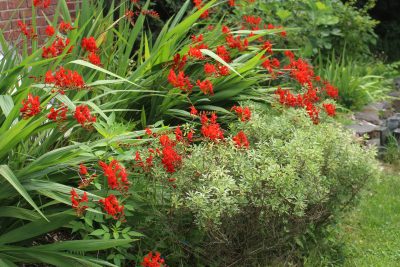
The crocosmias also multiplied, and they did so with such enthusiasm that there became just too many of them at the original location. So I started digging. And I uncovered bulb after bulb after bulb, ready to bloom and multiply next year. Now I have to decide what to do with all those bulbs. Plant them? Give them away? Compost them? I would have never thought I could have had too many crocosmias.
Glads Won’t Die
Does anybody around here still dig up their gladiolas each fall? I don’t, but to no avail. Left outside, they still survive every winter. Yuk. (Gladiolus “bulbs” are, like crocosmia “bulbs,” actually bulb like structured called “corms.”)
I don’t like gladiolas. Perhaps it’s because they are the most popular flower for funerals.
At any rate, I did, for some reason, plant some glads over 30 years go, glads whose beautiful salmon, pink color I subsequently felt was wasted on glad flowers. The nice color couldn’t outweigh the funereal associations, so after a couple of years of digging them up for storage each fall, I decided to sacrifice them to winter cold.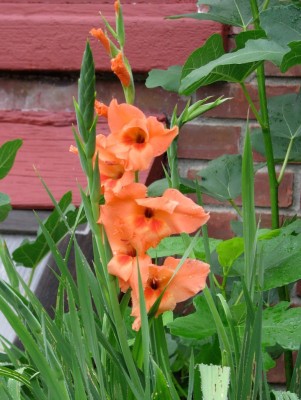
Unfortunately, they reappeared each year, and have continued to do so annually. I have to chuckle whenever I read instructions such as: “Corms should be dug after foliage has matured and started turning brown. Lift corms carefully with a spade or spading fork, taking care not to cut into the corm. Cut the tops off 1inch above the corm and dry for 2 to 4 weeks in a warm location (70-80 degrees Fahrenheit) with good air circulation. Remove the old corm which is beneath the new corm. Discard any rotted or damaged corms. Cut stems back to within an eighth of an inch of the corm. Place the corms in an onion sack or old nylon panty hose. Hang from a wall or ceiling. Ideal storage temperatures are between 35 and 40 degrees Fahrenheit.”
Hah! Doing nothing at all has, unfortunately, worked fine for me. At least the gladiolas haven’t multiplied as fast as the crocosmias.
Cold Air, Not So Cold Soil
The whole concept of winter hardiness for a plant only whose roots (or corms, in the case of crocosmia and gladiola) need to survive winter is hazy. After all, three feet down in the soil almost everywhere, temperatures hover around 50 degrees Fahrenheit.
Lay some mulch on top of any soil and penetration of winter cold can’t reach as deeply as through bare soil or lawn. Bare soil doesn’t peek out anywhere in my garden. Whatever is not lawn has been mulched year after year for many years with leaves, wood chips, sawdust, compost, hay, or whatever other organic materials I can get my hands on. (No, my garden isn’t three feet higher than it was when I started because those organic mulches decompose, enriching the soil as they do so.)
Nonetheless, the ground that the crocosmias and glads call home is well-insulated from winter cold. Warmer winters for the past few years have also helped these “nonhardy” bulbs survive outdoors, especially the less cold-hardy gladiolus.
Of Worms and Leaves, Here and Beyond
/25 Comments/in Gardening, Pests, Soil/by Lee ReichUnreiking is Good Exercise
For the past few days I’ve been engaged in the esoteric exercise of unreiking. Basically, this involves lifting heavy (or sometimes light) sacks, slitting them with a knife, and then moving my arms back and forth over the spilled contents. Okay, okay, the “sacks” are plastic bags, their contents are autumn leaves, and I’m holding a pitchfork in my hands as I spread out the spilled leaves.
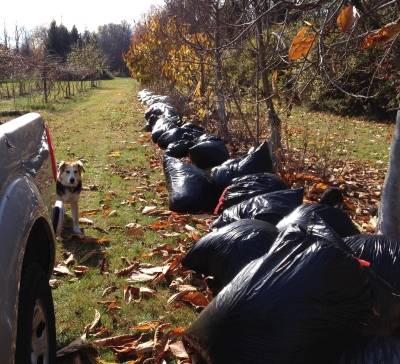
Sammy is looking forward to this leafy mattress
(Unreiking is the reverse of another esoteric exercise, reiking, whereby . . . well, leaves are raked up into plastic bags.)
Some people have too many leaves or otherwise don’t want them around. I have too few leaves and have use for them. By unreiking, the leaves get spread beneath my berry bushes, grape vines, and pear trees. These leaves feed bacteria, fungi, and other soil microbes, which slowly rot down the leaves to enrich the ground with nutrients and add organic matter that helps the soil hold both moisture and air.
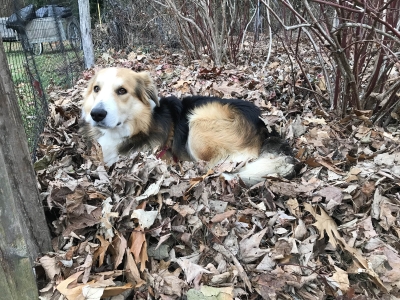
Ahhhhhh
After doing this autumn after autumn for many years, the ground beneath these plants is as good as any agriculture soil in the world.
A Gardener’s, Farmdener’s, and Farmer’s Friend, Reconsidered
Our forest soils are similarly enriched, though to a lesser degree, with each autumn’s leaf drop. But change is under way, and the culprit is the earthworm.
Backtrack to about 12,000 years ago; that’s when the last glacier receded from the northern parts of the U.S. The glacier froze, compacted, churned and moved soil everywhere north of New Jersey, the upper parts of Pennsylvania, Ohio, Indiana, and Illinois, and parts of Wisconsin and South Dakota. Most of North Dakota was also enveloped by the the glacier, as well as, moving further west, the northern parts of the northern most states. In so doing, it killed off any native earthworms.
The still existing native earthworms to the south could have migrated back up here, but they move very slowly. Earthworms’ top speed is estimated at less than 6 yards per year.
Here, north of that line of glaciation, you and I do see earthworms in our soil. They’re not native; they arrived here nestled within pots of soil and organic debris, and as discarded soil ballast in ships, beginning in about the 17th century, with European colonists. And they liked it here.
More recently, those European immigrants — the worms, that is — were joined by worms from Asia.
Both species of non-native earthworms continue to spread in the soil of potted plants, in compost and leaf mulches, in home composting kits, and in discarded fishing bait (“nightcrawlers”).
Problem is that a few species of these non-native earthworms are very good a decomposing the leafy mulch that blankets forest floors. The blueberry, mountain laurel, rhododendron and other shrubs and ground covers in our forests thrive in that leafy mulch. The action of these non-native earthworms threatens to change the character of our forests.
Eek, A Snake Worm!
A number of years ago, my friend Sandy told me of strange happenings in her garden, of the abundance of worms and worm castings to the extent that the soil became so loose that her plants were flopping over. I pooh-poohed this report until a bit of research revealed this invasive worm issue.
I couldn’t offer Sandy any advice on what to do and, in fact, there’s no recommended way to deal with invasive worms. Discarding fishing bait at the end of a fishing day is one way these worms spread. (Sandy’s husband does fish.) They also can be spread in potted plants and in composts that were insufficiently heated and in mulches. (Uh oh; what about all my leaf hauling?)
For all the compost I make and spread, and all the leaves and other organic materials I haul here to the farmden, I come upon surprisingly few worms. One did catch my eye the other day, something about the way it moved and its robustness.
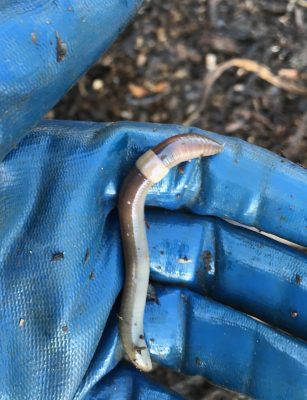
Crazy snake worm?
Could it be the European Lumbricus terrestris? Could it be the Asian “crazy snake worm”(probably Amynthas agrestis or A. tokioensis). Judging from the crazy way it moved and the pale collar (clitellum) circling its body completely, I’m guessing it’s one of the crazy snake worms.
Earthworms have always been a friend of gardener and farmer. Charles Darwin was a notable champion of them. After spending a lot of time on his belly in observation of these creatures, he wrote up his observations in a book, The Formation of Vegetable Mould through the Action of Worms. Darwin calculated that earthworms (probably Lumbricus terrestris) brought 18 tons of nutrient-rich castings to the surface per acre per year, in so doing tilling and aerating the soil while rendering nutrients more accessible for plant use. He wrote that “worms played a more important role in the history of the world than most persons would at first suppose.”
In our forests, European and Asian earthworms can eliminate leaf litter and change the soil composition to create conditions that favor non-native plants, decrease native plant biodiversity, and result in less understory vegetation. To the gardener and farmer, earthworms are a friend.
Greenhouse Happenings, Figs and Lettuce and . . .
/9 Comments/in Fruit, Gardening, Planning, Vegetables/by Lee ReichDarkness Descending
Plant growth has come screeching (almost) to a halt. Lettuces just sit, hardly growing. No wonder, you are no doubt thinking. It’s getting colder and colder outside. I know that, but I’m writing about lettuces in my greenhouse. The issue isn’t lack of heat. It’s lack of light.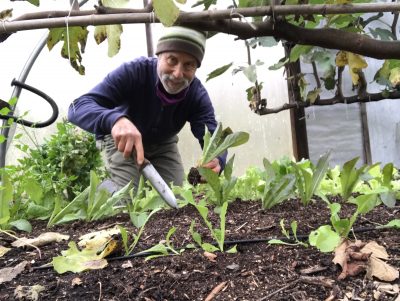
For more evidence that light is the issue, look to good vegetable gardens in southern Europe. In that mild climate, harvest from a well-planned vegetable garden continues year ‘round. But year ‘round harvest there takes planning — lack of light also makes for very slow growth over there in these darkest months. Unprotected plants survive because the winter weather never gets that cold over there. (And cool-season vegetables, such as spinach, radish, and turnips, that we plan for sprig or fall, are what do well in Mediterranean winters.)
My garden here in the Hudson Valley, at about the 42nd parallel, experiences winter day lengths the same as Rome, Italy or the island of Corsica — all on about the same 42nd degree of latitude. If lettuce plants grow slowly in Rome and Corsica, then the slow growth of lettuce in my greenhouse should come as no surprise. But it always does surprise me, and the brakes seem to start getting applied back in October, with full pressure about now.
All this came to the forefront of my attention back in 1992, when I read Eliot Coleman’s excellent book Four-Season Harvest. After highlighting the similar insolation of much of our “northern regions” with much of balmy Europe, he went on to describe various ways of protecting winter vegetable from our winter cold, which would kill most of them. Keeping the plants a bit warmer also gets them growing sooner once days become longer and brighter.
My goal, in the greenhouse, is to get a good share of the plants almost fully grown going into December. With lettuces, I try to plan to have enough of them to fill salad bowls through January and February, after which smaller plants are starting to grow fast enough to fill those bowls.
The 42nd Parallel
The reason Corsica and Rome remain relatively balmy all winter while winters here, with both locations at the 42nd parallel, get so frigid is that Corsica is bathed by the Gulf Stream, that warm mass of air that flows up from the Caribbean and across the Atlantic to wash over western Europe.
The warm touch of the Gulf Stream is lost as you move further east across Europe and into western Asia. Kazakhstan, parts of which also lie at the 42nd parallel, experience average annual temperatures from -60°F to 104°F!! The climate of nearby Turkey, whose north end touches that latitude, is moderated by the Caspian Sea. Moving further east to parts of Inner Mongolia, still within the 42nd parallel, winter temperatures might dip to -90°F.
A Greenhouse is not a Hothouse
If you were to join me in my greenhouse today, don’t forget your hat and gloves. The greenhouse is heated, but only minimally, enough to keep the temperature from falling below 37°F. That temperature provides a nice balance between energy use and reasonable year ‘round harvest. (Expotentially more energy is needed for incrementally increasing temperatures.)
Today is rainy and very cool, but not cool enough to kick on the greenhouse heater. So it’s pretty much the same temperature inside the greenhouse as outside the greenhouse — in the 40s. Most of what’s growing — kale, celery, mâche, claytonia, Swiss chard, mustard greens, parsley, and arugula — do fine with these conditions.
Leafy vegetables require less energy (i.e. sunlight) than do fruiting vegetables, so the low light is also fine to keep them happy even if only slowly growing, just as they would be planted (outdoors) in a garden in Corsica or Rome.
That’s also home to my baby, hardy cyclamens (about which I recently wrote), in a seed flat, until they decide to lose their leaves and go dormant. And two cardoon plants, also native to Mediterranean regions.
One Mediterranean plant that is very unhappy this year, even in the greenhouse, is fig. Figs are still ripening but, with the high humidity and low light, each is soon covered with fuzzy, gray mold. 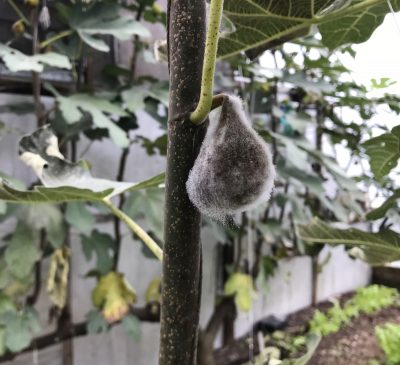
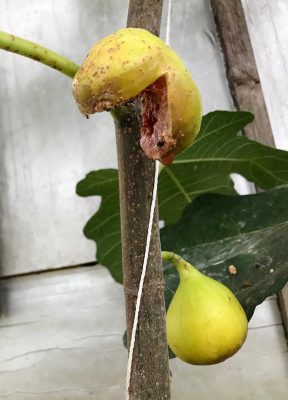 Roots of Rabbi Samuel fig, near the endwall, spread under the wall and outside the greenhouse, soaking up so much water that the figs split before ripening. Yet, a few fig fruits escape both afflictions and ripen to juicy sweetness.
Roots of Rabbi Samuel fig, near the endwall, spread under the wall and outside the greenhouse, soaking up so much water that the figs split before ripening. Yet, a few fig fruits escape both afflictions and ripen to juicy sweetness.
I wonder if fig gardeners in the Mediterranean share my fig problems.